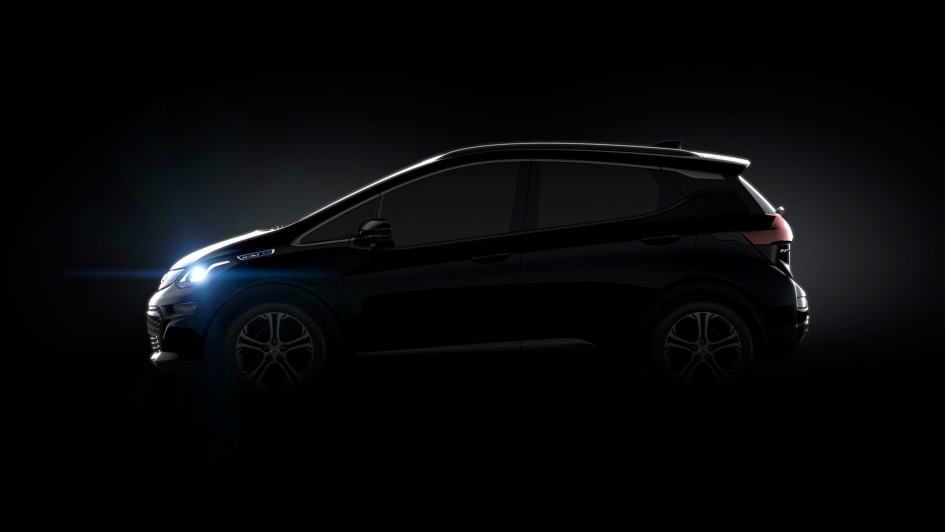Partager la publication "Chevrolet Bolt EV : the electric automotive ! Moteur 60 kWh by LG Electronics. GM is back!"
Quand on évoque Chevrolet, tout de suite on pense à la Corvette ou encore à la Camaro. Mais Chevrolet c’est aussi un constructeur comme Renault, il y a la R.S.01 et la Zoé ! Donc on va présenter la Chevrolet Bolt EV. L’automobile a été pré-annoncé et présenté au CES début janvier 2016, via la Keynote de GM et présenté au NAIAS 2016 à Detroit, lors de la Press Conference du constructeur. Considéré comme l’une des principales voitures électriques attendues en 2016, le projet Bolt a été révélé aux médias et au public. La Chevrolet Bolt EV est la première voiture tout électrique de General Motors, après l’hybride Chevrolet Volt. Ce véhicule électrique doit concurrencer la prochaine citadine de Tesla. La Bolt se veut accessible et avec beaucoup d’autonomie. Avec la Chevrolet Bolt EV 2017, General Motors prend surtout de vitesse Tesla et sa Model 3 avec un an d’avance. C’est le retour de l’automobile Made in Detroit, face à la R&D from Sillicon Valley dans la course à l’automobile écologique. La Chevrolet Bolt EV est l’équivalent d’une petite sportive, mieux que la BMW i3 en puissance et autonomie, et concours sur le ring avec le poids d’une VW e-Golf, tout en proposant +200 ch d’équivalent en puissance électrique avec 60 kWh.
Histoire de constructeur – Chevy & General Motors
Chez DM, comme vous le savez, j’apprécie découvrir le parcours des entrepreneurs devenus grands constructeurs, à travers la présentation d’un modèle. On va donc continué l’histoire de Louis Chevrolet, initialement commencé avec Buick, la marque à l’origine des débuts de Generals Motors.
1900 – 1920 – Chevrolet & Buick
==> Buick Avista concept ravive la perf’ et marque origine de General Motors à Detroit au NAIAS 2016
Résumé ci-dessous, de ce qui a été raconté dans mon article de présentation du Buick Avista concept, lien ci-dessus.
En 1908, Bill le patron de Buick a créé General Motors, puis a rencontré un certain Louis Chevrolet, en 1911. Quelques temps après et aventure économico-business, Bill obtient le nom Chevrolet et ses voitures. La crise économique de 1920 minant l’action GM, puis Bill est évincé définitivement de la présidence de General Motors.
1920 – 2015 – Chevy & Buick & GM
L’entreprise Chevrolet fusionne avec l’entreprise Buick et les autres marques du groupe General Motors. GM devient un empire colossal emploie rapidement 100 000 employés dans 70 usines, en concurrence direct des empires Ford et Chrysler.
Louis Chevrolet décide alors de reprendre sa carrière de pilote automobile avec ses jeunes frères Arthur Chevrolet et Gaston Chevrolet, également pilotes et mécaniciens. Louis Chevrolet crée la marque Frontenac, qu’il destine à la compétition et notamment aux 500 miles d’Indianapolis, l’épreuve reine du sport automobile américain. En quatre participations à l’Indy 500, Louis obtient son meilleur résultat avec une 7ème place en 1919.
En 1920, qualifié en première ligne, Louis est rapidement contraint à l’abandon mais se console largement avec la victoire de son frère Gaston, qui fait triompher la Frontenac familiale. Mais en fin d’année, Gaston se tue dans une épreuve en Californie, ce qui incite Louis à mettre un terme à sa carrière. Sa nouvelle marque, Frontenac, gagnera 2 fois les 500 miles d’Indianapolis dans les années 1920.
Dans ces même années 1920, il lance avec Arthur une entreprise de construction de moteurs d’avion, mais une dispute avec son frère, puis la crise de 1929 le ruinent. De retour chez Chevrolet, il finit ses jours en tant que simple mécanicien dans les usines de Détroit, jusqu’à ses 62 ans, en 1941.
La marque Chevrolet a continué dans les années 1920, 1930 et 1940, d’être compétitive pour GM face à l’empire Ford et face à Chrysler, qui créa la marque Plymouth afin d’amener au groupe Chrysler une nouvelle clientèle populaire.
Vauxhall est rachetée par General Motors en 1925.
1929 – GM & Opel & Chevrolet
En 1929, au cœur de la Grande Dépression, les frères Opel décident de céder 80 % de leurs actions Opel à General Motors. Un an plus tard, GM acquiert les 20 % restants. Après la dépression, les affaires commencent à reprendre. Opel est le premier constructeur allemand à lancer une compagnie d’assurance. En 1931, Opel produit cent mille automobiles.
General Motors a donc fait l’acquisition de la plus grande usine automobile d’Allemagne, celle d’Opel.
En 1929, Chevrolet créé le moteur six cylindres ‘Stovebolt’, donnant Chevrolet un avantage sur Ford, qui offrait qu’un seul quatre cylindres. Le marketing de Chevrolet affichait ‘A Six at the price of a Four’. Puis en 1933, Chevrolet a lancé l’auto ‘Six Standard’, qui a été annoncé comme la voiture à six cylindres la moins chère disponible sur le marché aux États-Unis.
1942 – WWII
À partir de février 1942, la GM, comme ses concurrents Ford et Chrysler ainsi que les autres constructeurs indépendants, reconvertit ses 94 usines pour l’effort de guerre américain durant la Seconde Guerre mondiale.
1950s – Chevrolet
Chevrolet a eu une grande influence sur le marché américain de l’automobile au cours des années 1950 et 1960. En 1953, elle a présenté la Corvette, Cabriolet 2 portes, type voiture de sport avec une structure en fibre de verre. La C1 est doté d’un moteur à six cylindres en ligne Chevrolet de 3.9L développant 160 ch. Plus tard, eEn 1957, Chevrolet a présenté son premier moteur à injection de carburant.
1970s – Chevrolet
Pendant les années 1960 et au début des années 1970, la Chevrolet standard, avec la série Impala de luxe, fut meilleurs ventes de l’histoire de l’industrie automobile de l’Amérique. La conception des moteurs Chevrolet a également été utilisé au cours des années dans les automobiles GM construites sous le marque Pontiac, Oldsmobile, Buick, Hummer, Opel en Allemagne, et Holden en Australie.
Summary Story – Chevrolet & GM
Chevrolet, referred to as Chevy and formally the Chevrolet Division of General Motors Company, is an American automobile division of the American manufacturer General Motors (GM). Louis Chevrolet and ousted General Motors founder William C. Durant started the company on November 3, 1911 as the Chevrolet Motor Car Company. Durant used the Chevrolet Motor Car Company to acquire a controlling stake in General Motors with a reverse merger occurring on May 2, 1918 and propelled himself back to the GM presidency. After Durant’s second ousting in 1919, Alfred Sloan, with his maxim « a car for every purse and purpose, » would pick the Chevrolet brand to become the volume leader in the General Motors family, selling mainstream vehicles to compete with Henry Ford’s Model T in 1919 and overtaking Ford as the best-selling car in the United States by 1929.
Chevrolet-branded vehicles are sold in most automotive markets worldwide, with the notable exception of Oceania, where GM is represented by its Australian subsidiary, Holden. In 2005, Chevrolet was relaunched in Europe, primarily selling vehicles built by GM Daewoo of South Korea with the tagline « Daewoo has grown up enough to become Chevrolet », a move rooted in General Motors’ attempt to build a global brand around Chevrolet. With the reintroduction of Chevrolet to Europe, GM intended Chevrolet to be a mainstream value brand, while GM’s traditional European standard-bearers, Opel of Germany, and Vauxhall of England would be moved upmarket. However, GM reversed this move in late 2013, announcing that the brand would be withdrawn from Europe, with the exception of the Camaro and Corvette in 2016. After General Motors fully acquired GM Daewoo in 2011 to create GM Korea, the last usage of the Daewoo automotive brand was discontinued in its native South Korea and succeeded by Chevrolet.
In North America, Chevrolet produces and sells a wide range of vehicles, from subcompact automobiles to medium-duty commercial trucks. Due to the prominence and name recognition of Chevrolet as one of General Motors’ global marques, Chevrolet, Chevy or Chev is used at times as a synonym for General Motors or its products.
GM dans les années 2000 : entre crise, faillite et reprise
En 2000, GM noue une alliance stratégique avec le groupe italien Fiat. L’Italien cède 20 % de son capital, en échange de 6,1 % de GM, l’Américain bénéficiant d’une clause d’achat des 80 % jusqu’en 2006. Les difficultés de Fiat l’ont incité à se désengager, bien que GM ait dû payer un dédommagement de 1,5 milliard de dollars au constructeur italien.
Au début des années 2000, la dette de GM est trop élevée par rapport à ses capitaux propres, le groupe ayant recouru à l’effet de levier de la sous-capitalisation pour doper sa rentabilité des capitaux propres. Le sauvetage se fera en quatre temps. De 2005 à 2008, pour éviter une augmentation de capital, GM recours d’abord à des désinvestissements massifs, l’État prenant le relais en décembre 2008 par 15 milliards de dollars de prêts d’urgence. Cette politique se poursuit au premier semestre 2009, sur fond d’effondrement des ventes, GM cherchant toujours à éviter une augmentation de capital. Mais en juillet 2009, un tribunal exproprie les actionnaires et les créanciers, au profit d’une nouvelle société « nouveau GM », créée de toutes pièces et dotée de 60 milliards de dollars de capitaux propres, quasiment sans dette. Les États américains et canadiens en sont actionnaires dès sa création en août 2009.
En décembre 2008, l’État prête d’urgence 17 milliards de dollars, sous condition de réduire la dette des deux-tiers, en la transformant en capitaux propres
Avec seulement 5 milliards de dollars de crédits bancaires, la charge d’intérêt du « nouveau GM » redevient normale56 et même favorable. Il regagne des parts de marché aux États-Unis57 puis redevient leader mondial en 2011 avec 9,02 millions de véhicules, 8 % de plus qu’en 201058. En conservant sa filiale Opel et en bénéficiant d’un fort rebond de sa production, le constructeur va en réalité stabiliser voire augmenter légèrement ses effectifs entre 2009 et 2012.
Le 19 novembre 2010, le retour en bourse de GM a été une réussite avec une augmentation de 9,1 % des titres au plus fort de la journée. Mais, en novembre 2010, Pontiac (célèbre pour ses Firebird et ses GTO) ferme ses portes, ainsi que Saturn, une filiale américaine de General Motors.
2010 – GM reinvention
La division Chevrolet a largement récupéré de la récession économique 2007-2010 grâce au lancement de nouveaux véhicules et améliorer les lignes existantes. GM a commencé à développer des voitures davantage efficients pour rivaliser avec les constructeurs étrangers.
Alors patron de General Motors, Fritz Henderson, avait indiqué lors d’une conférence de presse retransmise sur Internet en août 2009 que la Volt consommerait un gallon d’essence pour 230 miles parcourus en ville, soit environ 3,8 litres pour parcourir 370 km, ou 1,02 litre aux 100 km. Des valeurs qui en auraient fait la voiture à motorisation hybride la plus sobre du monde.
“From the data we’ve seen, most drivers could operate purely on grid electricity in a Chevy Volt. A car that gets more than 100 miles per gallon is a significant step in the reinvention of the auto industry and GM is and will continue to be a leader in that reinvention. » - Fritz Henderson, GM
Fin 2010, General Motors a commencé la production de l’automobile électrique Chevrolet Volt.
The Volt has won several awards, including the 2009 Green Car Vision Award, 2011 Green Car of the Year, 2011 North American Car of the Year, 2011 World Green Car, 2012 European Car of the Year, and 2016 Green Car of the Year.
GM is back
En décembre 2013, l’état américain sort totalement du capital de General Motors, en ayant fait une moins-value de 10,5 milliards de dollars, mais qui est inférieure aux coûts engendrés à l’État américain si General Motors avait fait faillite. Avec 9,71 millions de véhicules vendus en 2013, General Motors reste le deuxième constructeur au monde devant Volkswagen.
GM & Chevrolet in USA & Opel en Europe & Vauxhall in UK
General Motors décide de mettre fin, le 5 décembre 2013, à la concurrence entre ses marques sur le marché européen, en retirant Chevrolet pour laisser le champ libre à ses filiales allemande Opel et britannique Vauxhall, à compter de début 2016.
« En raison de la situation économique et du paysage concurrentiel, la marque Chevrolet ne sera plus représentée ni distribuée en Europe d’ici la fin de l’année 2015. Nous estimons qu’il s’agit là d’une décision stratégique qui profitera aux deux marques, en Europe comme ailleurs. GM a tout intérêt à avoir un Opel et un Vauxhall en pleine forme. Le retrait de Chevrolet nous aidera à progresser en Europe. » - Steve Girsky, vice-président de General Motors
En complément à ce sujet lire l’article intitulé Chevrolet quitte l’Europe au profit d’Opel, via automobile.challenges.fr
General Motors & LG Electronics team up!
En octobre 2015 General Motors & LG annonce leur partenariat ! General Motors a créé un vaste partenariat avec LG pour la Chevrolet Bolt EV. Plusieurs divisions de l’entreprise coréenne ont contribué au développement de la voiture électrique, qui sera mise en fabrication l’an prochain.
LG powered Bolt by General Motors
LG est depuis plusieurs années le principal fournisseur de batteries lithium-ion pour les voitures électriques de General Motors. Pour la Bolt, il fournira une douzaine de systèmes et composants, parmi lesquels les batteries, les moteurs électriques, le tableau de bord ou encore le système d’infodivertissement. La division LG Electronics a investi plus de 250 millions de dollars en Corée du Sud pour développer et fabriquer des équipements pour la nouvelle voiture électrique de General Motors.
Les deux entreprises ont souligné que leur partenariat était « sans précédent » et marquait un tournant dans le processus traditionnel de développement. La coopération a permis à General Motors de maîtriser le coût de la Bolt et d’en accélérer le développement.
‘Chevrolet needs to be disruptive in order to maintain our leadership position in electrification. By taking the best of our in-house engineering prowess established with the Chevrolet Volt and Spark EV, and combining the experience of the LG Group, we’re able to transform the concept of the industry’s first long range, affordable EV into reality.’ - Mark Reuss, GM executive vice president of Global Product Development, Purchasing and Supply Chain
‘Being selected as GM’s EV technology partner positions LG as a key player in next-generation vehicular technologies. The opportunity to work with GM on such game-changing technology is indicative of exactly the type of contributions that traditional tech companies can make in the automotive space.’
- Woo-jong Lee, president and CEO of the LG Electronics Vehicle Components Company
Chevrolet Bolt EV – CES 2016 & NAIAS 2016
Le projet Bolt a été révélée le 5 janvier par General Motors dans le cadre du CES 2016 à Las Vegas. Le show/Keynote a pour la première fois été diffusé en live via les réseaux sociaux. Cependant, la version définitive et les spécifications techniques ont attendus quelques jours pour the NAIAS 2016 à Detroit.
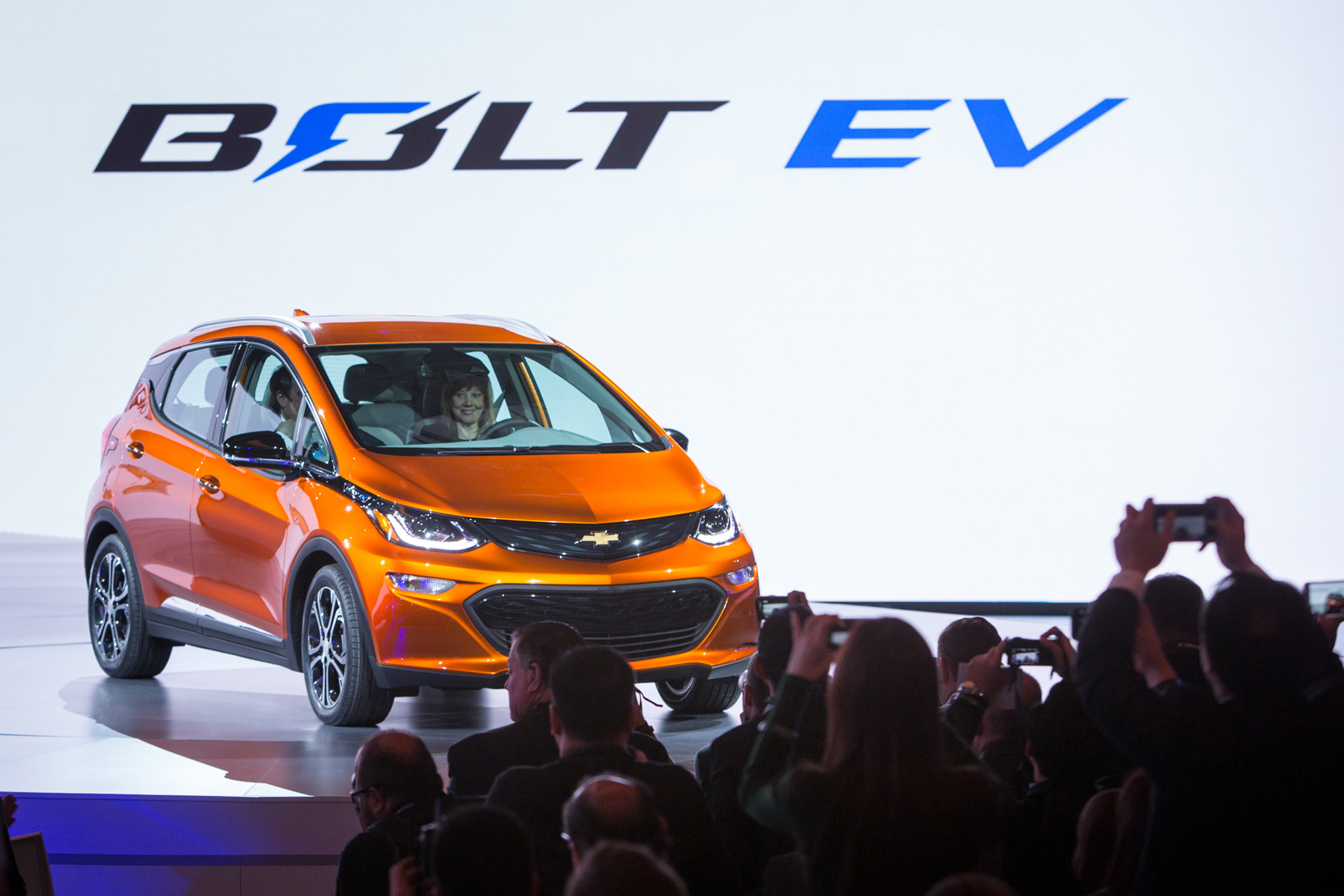
Chevrolet Bolt EV – 2016 – NAIAS – General Motors
Et si Chevrolet n’est plus disponible en Europe, il est néanmoins permis d’envisager que cette automobile moderne, bien équipée et hich-technologique soit disponible un jour en Europe via la marque Opel. Car, la Bolt EV promet beaucoup : 320 km d’autonomie via des batteries lithium-ion logées dans le plancher, un équipement au niveau des standards actuels et un système d’info-divertissement-telecom haut de gamme.
Le concept Chevrolet Bolt EV est la première concrétisation des ambitions de GM de donner naissance à un véhicule électrique qualifié d’abordable, et capable d’une autonomie de 200 miles (320 km). Au final l’idée derrière cette Bolt semble assez proche de celle qui a donné naissance à la Renault Zoé : donner accès à l’électrique au plus grand nombre.
…Quand on évoque Chevrolet, tout de suite on pense à la Corvette ou encore à la Camaro. Mais Chevrolet c’est aussi un constructeur comme Renault il y a la R.S.01 et la Zoé ! Donc on va présenter la Chevrolet Chevrolet Bolt EV. …
Et si ces 320 km sont annoncés, voire dépassés avec la Bolt. C’est grâce à une nouvelle architecture faisant un maximum de place dans le plancher pour des batteries de dernière génération produites par LG. Les batteries embarqué sur la Bolt totalisent 60 kWh. C’est le double de la plus récente la Nissan Leaf, le véhicule électrique le plus vendu au monde, qui n’offre que 30 kWh. La nouvelle génération est attendue pour 2017 avec 40 kWh de batterie. 60 kWh, c’est précisément la capacité des batteries de l’ancienne Tesla Model S d’entrée de gamme, une voiture de 5 mètre de long et presque 2 tonnes qui a connu un certain succès.
Les ingénieurs et mécanos de Detroit ont réussi à prendre de vitesse les ingénieurs et dev’ de Tesla dans la course à la voiture électrique pour le public-mass.
Next-Gen Volt & Bolt EV Concept: 2015 North American International Auto Show – #NextGenVolt – Chevrolet
The Next Gen Volt and the Bolt EV concept car were both revealed at the 2015 North American International Auto Show, showcasing Chevrolet’s commitment to innovation.
Cruze Hatch & Bolt EV Reveal: 2016 North American International Auto Show – Chevrolet
The all-new 2017 Cruze Hatch and the all-electric 2017 Bolt EV were both revealed at the 2016 North American International Auto Show. Get a first look at Chevrolet’s latest innovations.
Bolt EV: All-Electric Car Testing at Milford Proving Ground – Chevrolet
The Chevrolet Bolt EV is redefining what an all-electric car can be, one test at a time. The camouflaged vehicle undergoes testing of range performance, fast charging, hill climb, ride and handling, and cabin noise at Milford Proving Ground. These tests will ensure that the Bolt EV will be a game-changer for electric vehicles.
Le moteur de la Chevrolet Bolt EV
La Chevrolet Bolt EV est propulsé par un bloc moteur électrique LG qui annonce la puissance de 147 kW, équivalent à 200 ch, et un couple de plus de 350 Nm. Chevy annonce le 0 à 60 mph en moins de 7,0 secondes.
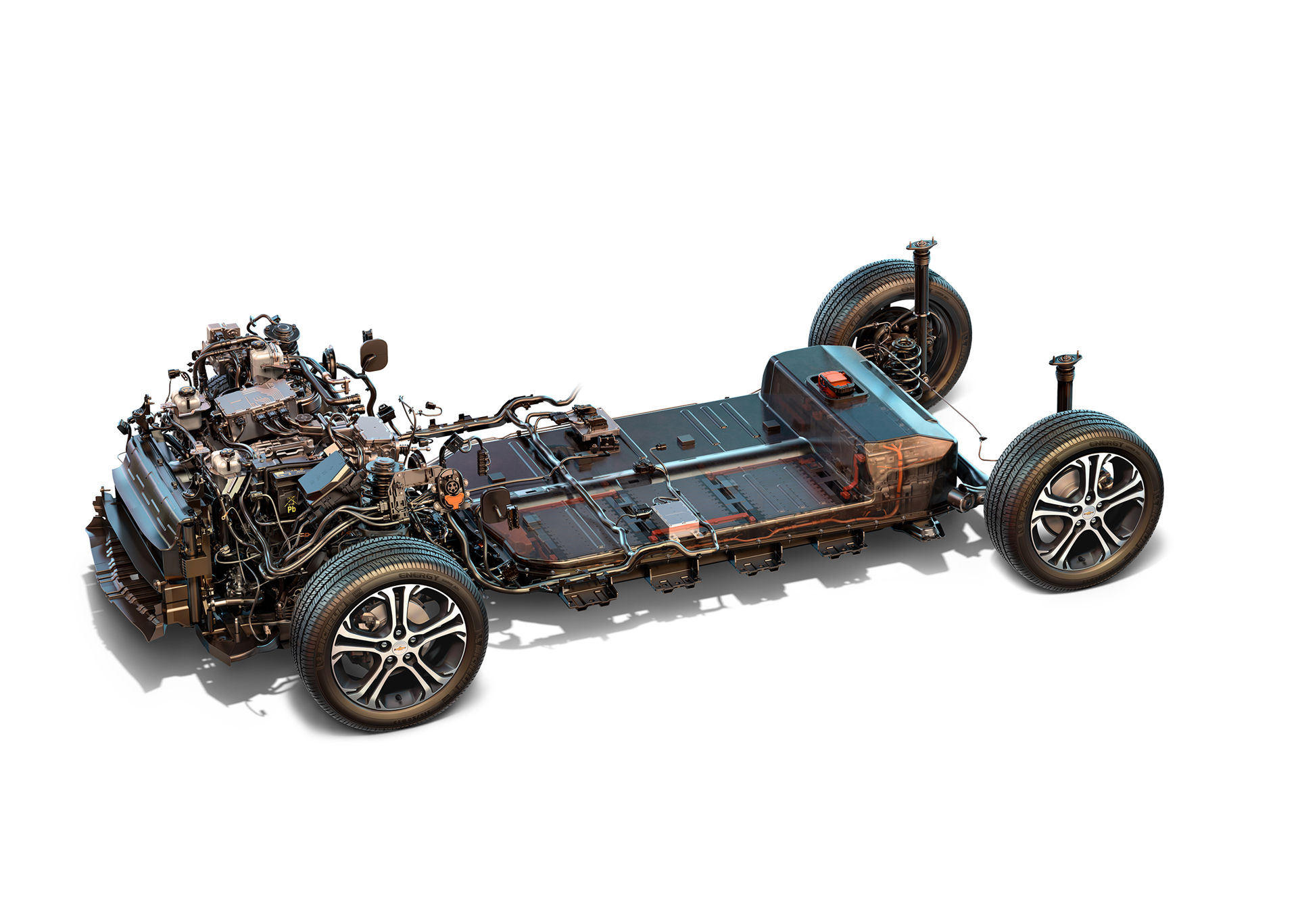
Chevrolet Bolt EV – 2016 – powertrain – General Motors
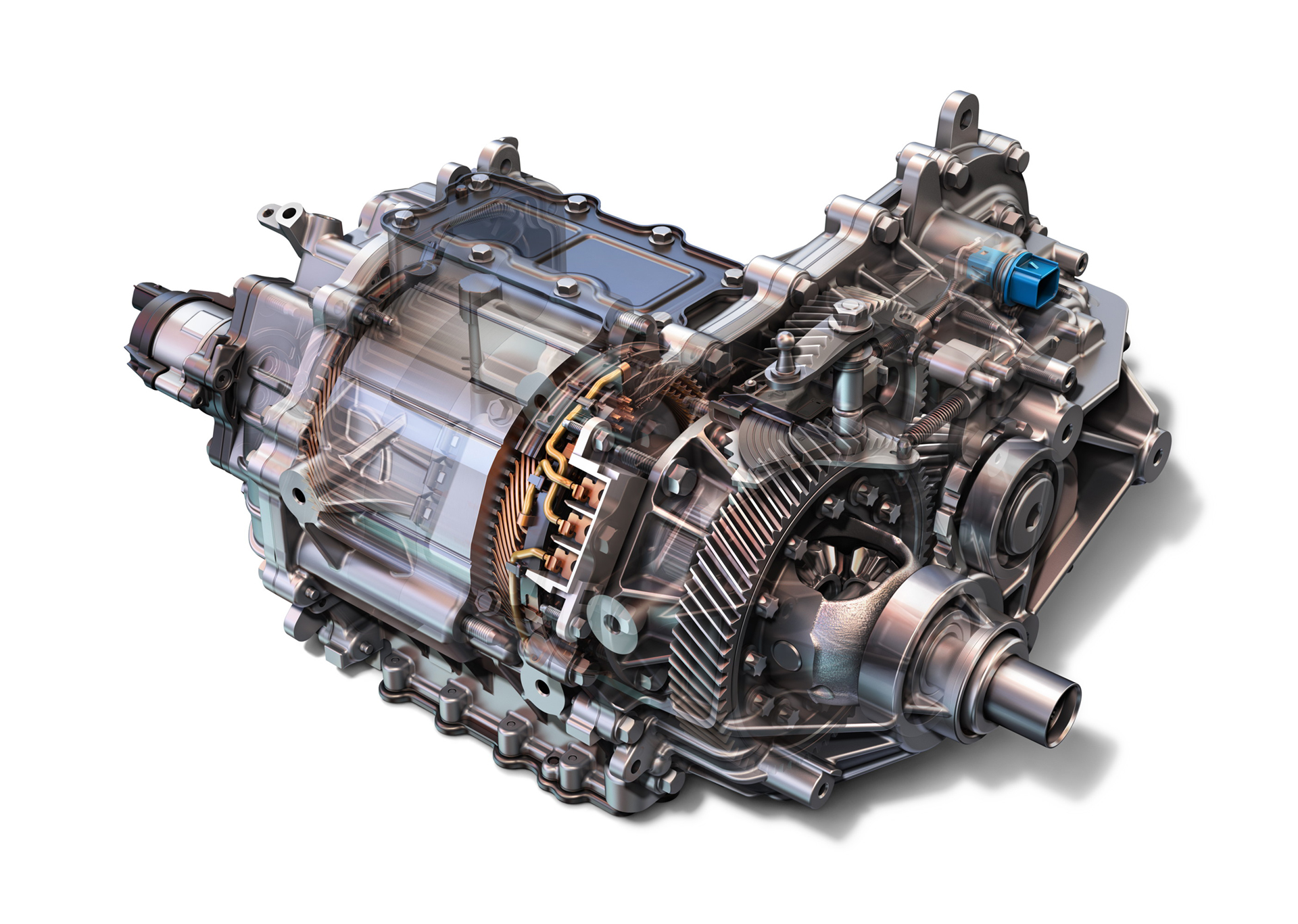
Chevrolet Bolt EV – 2016 – drive unit – General Motors
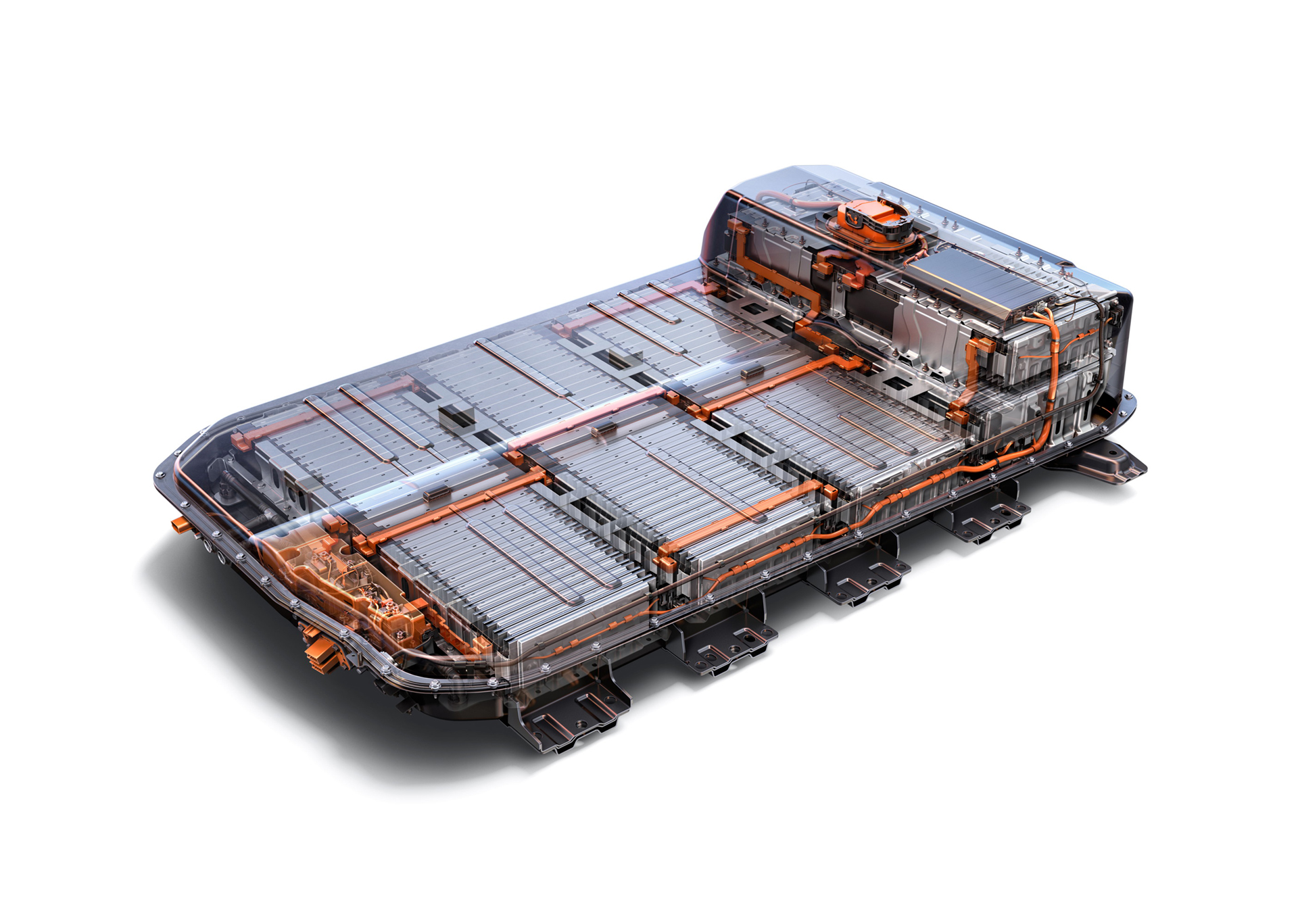
Chevrolet Bolt EV – 2016 – battery system – General Motors
La Bolt dispose de batterie lithium-ion via LG, d’une capacité de 60 kWh. L’ensemble pèse toutefois encore assez lourd puisqu’on annonce une masse de batterie de 435 kg.
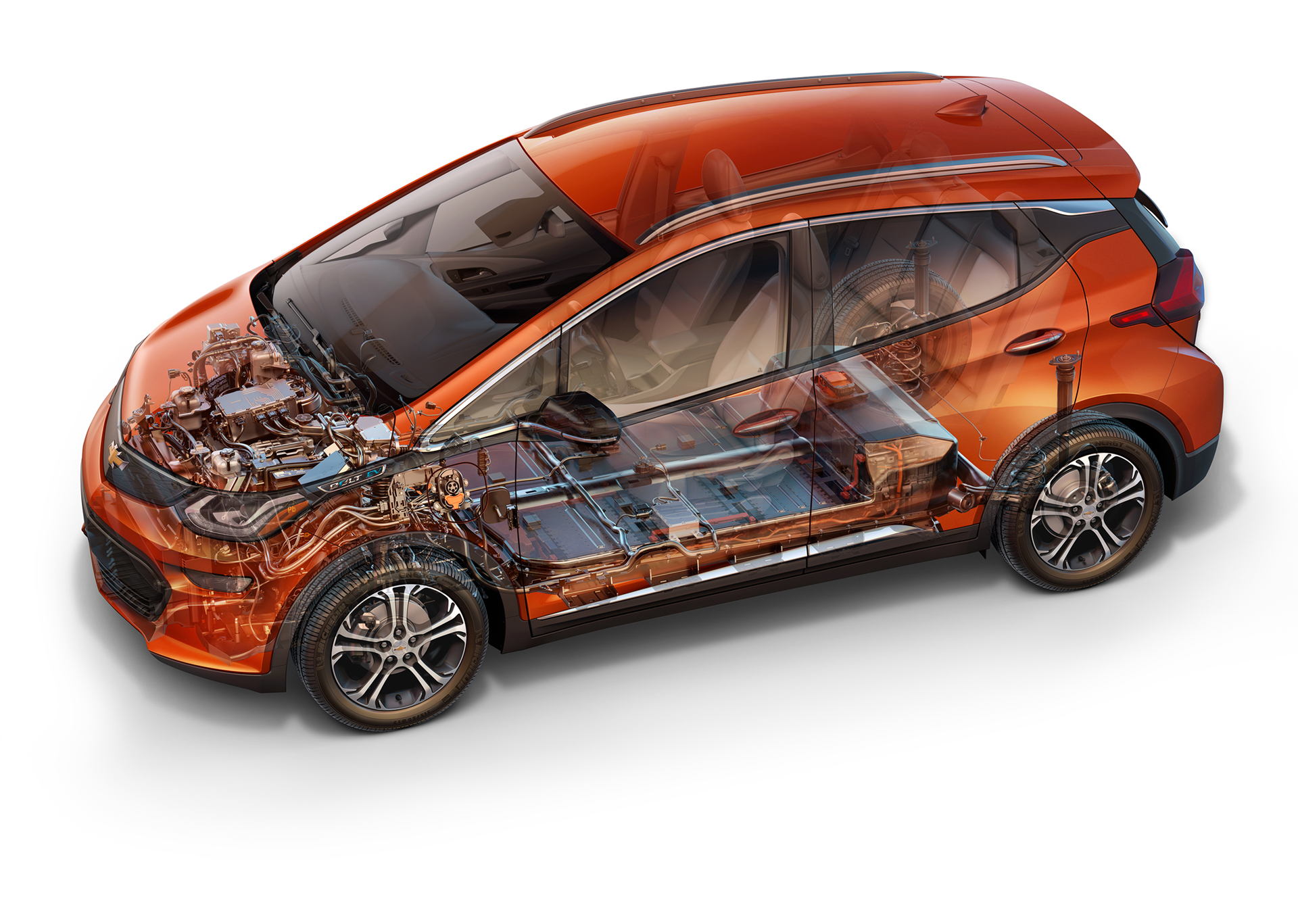
Chevrolet Bolt EV – 2016 – design mechanics – General Motors
Le design de la Chevrolet Bolt EV
The All-Electric 2017 Bolt EV – Chevrolet
With an estimated more than 200 miles of range on a single charge, the Bolt EV redefines exclusive efficiency. Introducing the all-electric 2017 Chevrolet Bolt EV.
Le design extérieur de la Chevrolet Bolt
La nouvelle Chevrolet Bolt se présente sous la forme d’un petit monospace. On devine ses inspiration de la Chevy Spark, bien sûr de la Volt mais aussi la nouvelle Opel Astra.

Chevrolet Bolt EV – 2016 – front side-face / profil avant – General Motors
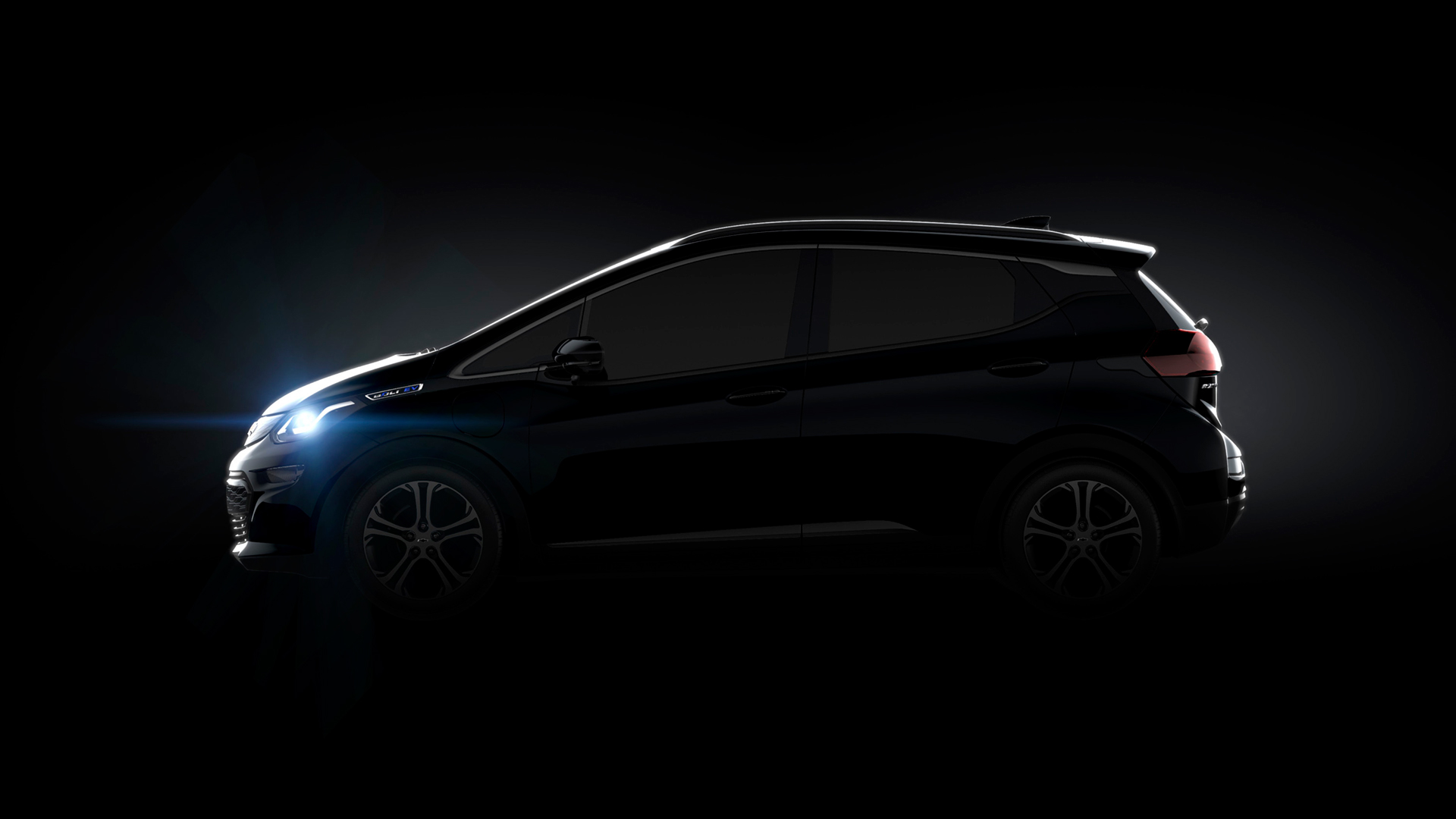
Chevrolet Bolt EV – 2016 – side-face / profil – General Motors

Chevrolet Bolt EV – 2016 – rear side-face / profil arrière – General Motors
Le design intérieur de la Chevrolet Bolt EV
A bord, on a une planche de bord avec une instrumentation numérique et un grand écran tactile positionné au niveau de la console centrale.
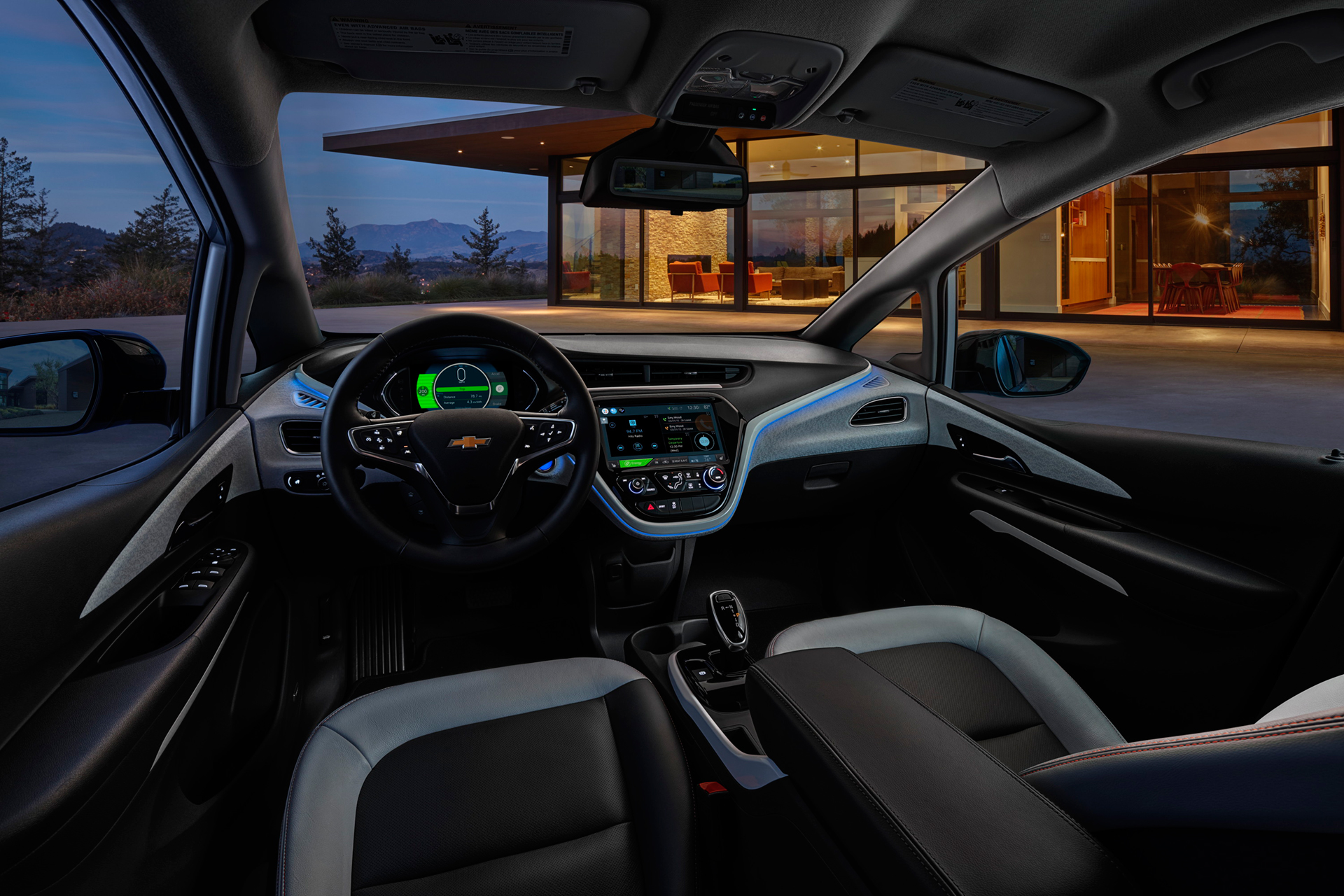
Chevrolet Bolt EV – 2016 – interior / intérieur – General Motors
Au final, La Chevrolet Bolt est l’équivalent d’une petite sportive, mieux que la BMW i3 en puissance et autonomie, et concours sur le ring avec le poids d’une VW e-Golf, tout en proposant +200 ch d’équivalent en puissance électrique avec 60 kWh.
English summary
General Motors & LG Electronics team up to build Chevrolet Bolt EV
DETROIT, Oct. 20, 2015 – General Motors set aside traditional vehicle development in selecting LG Electronics as its partner in developing the next generation Chevrolet Bolt EV (electric vehicle), which can travel more than 200 miles on a single electric charge.
Offering consumers the first long-range, affordable EV required an unprecedented supplier relationship combining expertise in infotainment, battery systems and component development with GM’s proven in-house capabilities in electric motor design, battery control, system validation and vehicle body/system integration.
Following joint planning and research, GM and LG brought the Chevrolet Bolt EV to reality. The Bolt EV concept was shown at the North American International Auto Show in January this year. Chevrolet confirmed in February that the Bolt EV would go into production at GM’s Orion Township, Michigan (USA) assembly plant in late 2016.
GM & LG Blend Expertise
Engineers considered different vehicle architectures, electric driving ranges and performance options for the Bolt EV before deciding the vehicle must be affordable and deliver 200-plus miles of all-electric driving with spirited performance. LG supplied an array of new components and systems for the Chevrolet Bolt EV, including:
-Electric Drive Motor (built from GM design)
-Power Inverter Module (converts DC power to AC for the drive unit)
-On Board Charger
-Electric Climate Control System Compressor
-Battery Cells and Pack
-High Power Distribution Module (manages the flow of high voltage to various components)
-Battery Heater
-Accessory Power Module (maintains low-voltage power delivery to accessories)
-Power Line Communication Module (manages communication between vehicle and a DC charging station)
-Instrument Cluster
-Infotainment System
‘Chevrolet needs to be disruptive in order to maintain our leadership position in electrification. By taking the best of our in-house engineering prowess established with the Chevrolet Volt and Spark EV, and combining the experience of the LG Group, we’re able to transform the concept of the industry’s first long range, affordable EV into reality.’ - Mark Reuss, GM executive vice president of Global Product Development, Purchasing and Supply Chain
LG Electronics’ Vehicle Components led a team of LG companies including LG Chem, LG Innotek and LG Display to help develop the Bolt EV. LG Electronics has invested more than $250 million in an engineering and manufacturing facility in Incheon, Korea, to support the component development and manufacturing for Bolt EV components.
‘Being selected as GM’s EV technology partner positions LG as a key player in next-generation vehicular technologies. The opportunity to work with GM on such game-changing technology is indicative of exactly the type of contributions that traditional tech companies can make in the automotive space.’
- Woo-jong Lee, president and CEO of the LG Electronics Vehicle Components Company
General Motors unveil the Chevrolet Bolt EV at the CES 2016
DETROIT – Chevrolet will unveil the 2017 Bolt EV at the International Consumer Electronics Show (CES) in Las Vegas on Wednesday, Jan. 6, and be the first auto brand to work with Facebook to debut a vehicle using Facebook Live.
With the addition of the Bolt EV to a lineup that includes the all-new 2016 Volt, 2016 Malibu Hybrid and Spark EV, Chevrolet will offer consumers more affordable, electrified vehicle options than any other major automotive brand – solidifying its position as the leader in electrification.
“The Bolt EV truly embodies the ingenuity that is at the core of everything we do at Chevrolet. The technologies and the engineering expertise behind the Bolt EV are tremendous examples of the kind of innovation we intend to offer our customers, across an array of products at a tremendous value – something only Chevrolet can deliver.” - Alan Batey, president of General Motors North America and head of Global Chevrolet
Building on the electrification expertise established by the Volt, the Bolt EV is a game-changing, long-range electric vehicle. Not only will it deliver more than a GM-estimated 200 miles of range, it will break the affordability barrier with a price below $30,000 after full Federal tax credits. The Bolt EV will also offer connectivity and infotainment technologies seamlessly integrating smartphones and other electronic devices important to today’s consumers.
Chevrolet’s four million Facebook fans will have the opportunity to be the first to experience the new Bolt EV – with both a live video of the debut as well as an immersive 360-degree interior video experience.
General Motors revealed the Chevrolet Bolt EV at the NAIAS
DETROIT – The 2017 Chevrolet Bolt EV does more than set a new benchmark for affordable, long-range EV driving. It also raises the bar when it comes to driving performance. Engineers developed the Bolt EV’s propulsion system to offer more than an estimated 200 miles (based on GM estimates) and a delightful driving experience that’s more akin to a compact sports sedan than a small utilitarian crossover.
“Being the leader in range and affordability means nothing if the car isn’t going to excite you each time you get behind the wheel. That’s why the team was tasked with delivering a propulsion system that would also make the Bolt EV an electric vehicle that owners would love to drive.”
- Josh Tavel, Chevrolet Bolt EV chief engineer
Single Motor Drive Unit
Like most EVs on the road, the Bolt EV’s drive system uses a single high capacity electric motor to propel the car. But it’s the smooth, powerful and quiet motor design, gear configuration and shift-by-wire system that separates it from the pack.
The engineering team designed the Bolt EV’s electric motor with an offset gear and shaft configuration tailored to meet efficiency and performance targets – most notably more than an estimated 200 miles of range. The motor is capable of producing up to 266 lb.-ft. (360 Nm) of torque and 200 hp (150 kW) of motoring power. Combined with a 7.05:1 final drive ratio, it helps propel the Bolt EV from 0-60 mph in less than seven seconds.
Power delivery is controlled by Chevrolet’s first Electronic Precision Shift system. This shift and park-by-wire system sends electronic signals to the Bolt EV’s drive unit to manage precise feel and delivery of power and torque, based on drive mode selection and accelerator inputs. A by-wire shifter requires less packaging space than a traditional mechanical shifter, resulting in more interior space and improved interior layout.
60 kWh Battery System
Having more than 1.3 billion miles of EV experience from the Chevrolet Volt helped Bolt EV battery engineers and strategic partner LG Electronics to develop an all-new cell and battery pack to offer more than an estimated 200 miles of range. Battery system preliminary specifications include:
-60 kWh lithium-ion battery pack.
-288 lithium ion cells
-Five sections
-10 modules
-96 cell groups – three cells per group
-960 lbs. (435 kg) total weight
“You usually have a battery cell that delivers either the desired levels of energy or power, but not traditionally both. With this cell design and chemistry we were able to deliver a battery system with 160 kilowatts of peak power and 60 kilowatts hours of energy.” - Gregory Smith, Bolt EV battery pack engineering group manager
The battery uses active thermal conditioning, similar to the Chevrolet Volt, to keep the battery operating at its optimum temperature, which results in solid battery life performance. The Bolt EV battery will be covered by an 8-year/ 100,000 mile (whichever comes first) limited warranty.
Inside the battery pack – which spans the entire floor, from the front foot well to back of the rear seat – is a new cell design and chemistry. The nickel-rich lithium-ion chemistry provides improved thermal operating performance over other chemistries, which requires a smaller active cooling system for more efficient packaging. The chemistry allows the Bolt EV to maintain peak performance in varying climates and driver demands.
The cells are arranged in a “landscape” format and each measures in at only 3.9 ins. (100 mms) high and 13.1 ins. (338 mms) wide providing improved packaging underfloor. The lower profile cell design enabled the vehicle structure team to maximize interior space.
The battery system is mated to a standard equipment 7.2 kW onboard charger for regular overnight charging from a 240-V wall box. A typical commute of 50 miles can be recharged in less than two hours. Bolt EV also features an optional DC Fast Charging system using the industry standard SAE Combo connector. Using DC Fast Charging, the Bolt EV battery can be charged up to 90 miles of range in 30 minutes. Outside temperatures may affect charging times.
Regen System Provides One-Pedal Driving
Regenerative braking has become more than just a tool to boost range, it’s also transformed into a feature that can provide an improved EV driving experience. The Bolt EV features a new regenerative braking system that has the ability to provide one pedal driving.
Through a combination of increased regenerative deceleration and software controls, one pedal driving enables the vehicle to slow down and come to a complete stop without using the brake pedal in certain driving conditions. When operating the Bolt EV in “Low” mode, or by holding the Regen on Demand paddle located on the back of the steering wheel, the driver can bring the vehicle to a complete stop under most circumstances by simply lifting their foot off the accelerator, although the system does not relieve the need to use the brake pedal altogether. Operating the Bolt EV in “Drive” mode and not pulling the paddle while decelerating delivers a driving experience where usage of the brake pedal is required to stop.
“Interviews with EV enthusiasts indicated their desire for one pedal driving capability on the Bolt EV. One pedal operation boosts the thrill and uniqueness of EV driving.” - Josh Tavel, Chevrolet Bolt EV chief engineer
Source et images
General Motors, Chevrolet
Partager la publication "Chevrolet Bolt EV : the electric automotive ! Moteur 60 kWh by LG Electronics. GM is back!"

